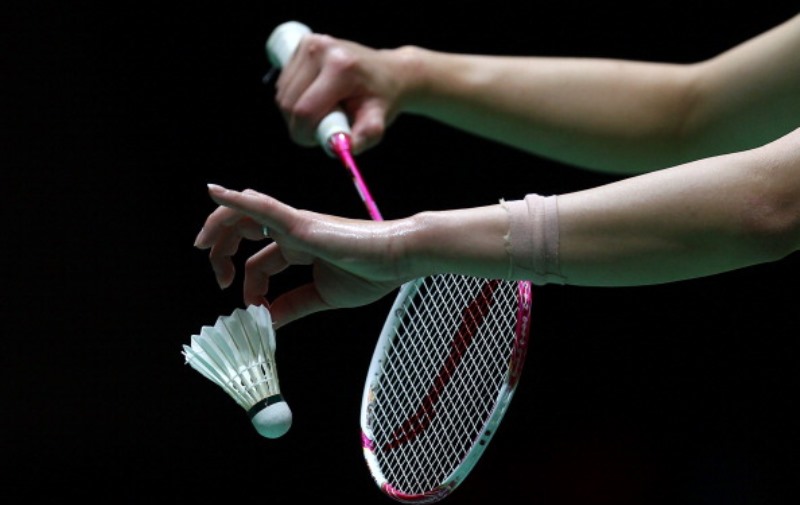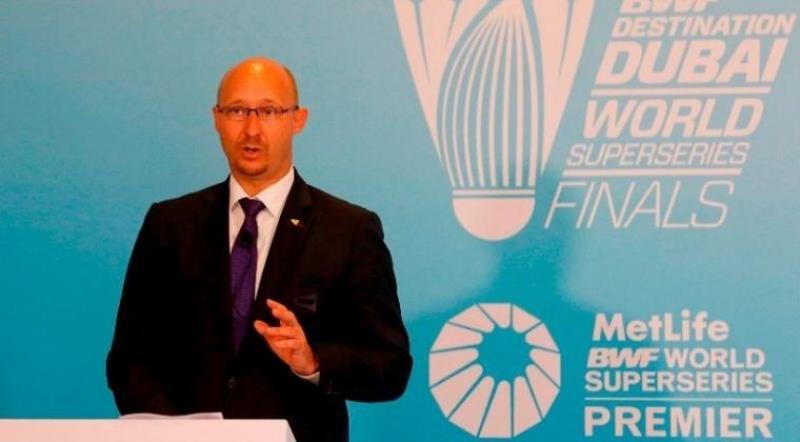
The Badminton World Federation is optimistic that the ongoing testing of the Experimental Service Law (Fixed Height) is the first step to making service rules and service judging simpler and more objective.
BWF Secretary General Thomas Lund says that, after trialling the fixed-height service experiment at two events so far, the world-governing body has received initial feedback from technical officials which has been positive and informative.
“The reaction from the global badminton community has been quite interesting. Feedback from umpires suggests the introduction of an instrument to help them in service-judging has helped. We have also noted some singles players have said they had no problem serving,” said Lund, acknowledging the critical views expressed by some players.
“There have long been complaints regarding the service laws in badminton and BWF wants to ensure greater fairness in service judging and how the laws are applied. Obviously, any time change is proposed – especially to such an essential aspect of a sport – there will be a wide range of views. We will take all of these into account.”
Addressing comments by some of badminton’s high-profile personalities, Lund stressed that before any decisions were taken there was detailed consultation with “top coaches from a number of badminton’s powerhouse countries”.
“During our consultation meeting, coaches agreed to test various fixed-height service options in certain countries. There was consensus on that being the next step and we did that. Thereafter, we agreed to test the Experimental Service Law (Fixed Height) at BWF events – which is what we are doing now,” elaborated the Secretary General.
Following the Badminton Association of Malaysia’s proposal last year to trial fixed-height serving – to which BWF membership agreed – BWF started experimental testing from 1 March. Testing started at the YONEX German Open on 6 March followed by last week’s YONEX All England Open Badminton Championships 2018. The Experimental Service Law (Fixed Height) mandates that “the whole of the shuttle shall be below 1.15 metres from the surface of the court at the instant of being hit by the server’s racket”.
All Grade 1 events – except the BWF World Junior Championships – will undergo testing as will Grade 2 events (the HSBC BWF World Tour and BWF Tour Super 100 events) and continental championships in April. As of now, testing is expected to run until year-end.
Lund disclosed that, depending on further feedback from the Experimental Period, “BWF would determine if 1.15 metres is the correct height or if it should be slightly higher”.
SERVICE HEIGHT EXPERIMENTAL PERIOD
MAIN OBJECTIVE RE. THE EXPERIMENT/CHANGES REGARDING THE SERVE:
- To make the service rules and the judging simpler and more objective to secure a higher level of fairness in matches for the players.
BACKGROUND:
Throughout a range of years players especially and also to some extent service judges have provided feedback that the service rules have been difficult to manage. Some of the weaknesses has been defined as the following – related to the two key service rules:
- The height of the bottom rib for players varies depending on the player’s height. It is difficult for the service judge to determine the exact location of the bottom rib as this can be difficult to see under the player’s shirt. Other issues that complicate service judging are loose-fitting shirts and the fact that players often change their shirts during the course of a match. These circumstances can create inconsistencies in service judging – which players have complained about for some time.
2. Another law says that “the shaft and the racket head of the server’s racket at the instant of hitting the shuttle shall be pointing in a downward direction”. Especially around a flick serve the racket can become flatter and not pointing in a downward direction, which has led to many players being faulted – something many players have argued about. In connection with a flick serve, the movement of the racket is however so fast that it can be very difficult for the human eye to determine precisely every time if it is a fault or not. So this law has resulted in objections on whether the service judge is always able to detect faults accurately.
- It has been clear for some time that the service laws and service judging related to the laws have been key areas of concern and many players (especially doubles players) have been struggling with the interpretation of these laws.
- Furthermore the Badminton Association of Malaysia in May 2017 put forward a proposal to agree on a fixed service height at 1.10 metres – or whatever height was felt appropriate – after having tested the system in tournaments. This proposal was accepted by BWF and preparations have been ongoing to introduce the test, giving players a transition period before starting the test and making sure service judges were trained.
RATIONALE FOR THE CHANGE:
- Changing to a fixed height provides the following advantages:
-
- Easier for umpires to determine the height (the bottom rib is not always easy to determine). This, in turn, will create consistency in service judging, which is one of the things players have been requesting.
-
- The possibility of including tools to help service judges to assess the serve – which is difficult with a service height that can vary a lot depending on the player’s height. Presently, a conventional physical tool has been created for the Experimental Period. Feedback from many service judges has been that this makes it easier for them to assess the serve.
-
- In the longer term, BWF is considering the development of a technology solution similar to what exists for line calls (Hawk-Eye Innovations). Such a development is complex, expensive and it will take time to ensure a consistent and reliable solution. This will be part of the development tasks once the preliminary results of the Experimental Period have been analysed.
- Another consideration regarding the fixed service height is the question: “Why should a very tall player be able to serve from a much greater height than a small player?” The serve in badminton and especially in doubles is a very important technical stroke to get the rally started and can make a big difference. The net height is equal for all and in connection with especially a short serve, the height of the serve makes a crucial difference in how a serve can be precisely delivered to gain an advantage in the rally. Clearly it is therefore a big advantage for a tall player to be able to serve from a higher level than smaller players. The philosophy around the service law has therefore been changed to provide an equal opportunity for all in connection with the serve as this stroke starting the rally is a very important stroke to form the game of a player or a doubles pair. It seems unclear to BWF why some stakeholders argue that taller players should gain an advantage around the serve – though BWF recognises this has previously been the case. However, this does not mean a different approach cannot be adopted.
- It has however been important for BWF to set a service height that is not unreasonable to very tall players. The first tests were conducted in a non-tournament environment and in one international tournament some years ago, and these tests were based on a service height of 1.10 metres. A number of the bigger badminton countries were then invited to provide feedback from tests in the national training environments, and feedback was provided that a fixed service height of 1.10 metres was probably too low, but a height around 1.15 metres was probably okay – though some said the service height should be set around 1.20 metres. A too-high service height can very easily result in an unreasonable advantage to the serving side (especially in doubles), so the service height in the experimental service system has been set at 1.15 metres. Compared to the original system with the height being determined by the “bottom rib”, then players with a height around 1.85 metres would have the lowest rib approximately around the height of 1.15 metres – and a height of 1.85 metres is still a reasonably tall player. But the main objective with the Experimental Period is to determine if 1.15 metres is the correct height or if it should be slightly higher.
- The Experimental Service Laws remove the rule that the racket shall point in a downwards direction. This is really a simplification of the service rule and will make it easier for players to deliver the serve – and will remove a number of the faults being judged during tournaments. With the removal of this rule, it is still important that the service height is not set too high as this could provide a risk that a too “aggressive” serve can be delivered with being able to serve very high and being able to rotate the rackets upwards whereby a very flat and fast serve could be delivered – something which is seen to be disruptive to the sport and not what BWF or players are seeking to achieve. The service height is therefore being assessed in tandem with looking at how the removal of the rule related to the downwards direction of the racket will work.
FIRST FEEDBACK:
- The first feedback from umpires is that the physical instrument does make it easier to provide more consistent and reliable service judging. This will therefore provide better consistency and more fairness around this area.
- Some feedback from singles players has indicated that serving is not a major issue. Some feedback has also come from some players – especially taller players – where the service height has been argued to be too low.
- Some feedback argues that no changes should be considered. However, BWF cannot disregard years of feedback from players that there are problems around the consistency of service judging under the existing rules. BWF generally agrees that existing service regulations provide a challenge for service judges to rule on all faults and this does not ensure the fairness which BWF is seeking to achieve.
- Very little or no feedback has yet been received from any players, coaches or other stakeholders to suggest other ways to deal with the problem around the service laws, but it is expected that more feedback will be received as the Experimental Period progresses.


































